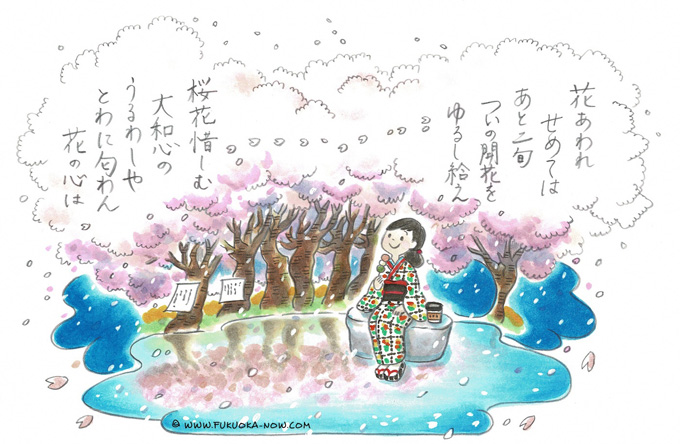Hakata Culture vol.182
The Hibaru Cherry Trees: A Testament to the Will of the People of Fukuoka

There is a widely known story about the famous Hibaru cherry blossoms in Minami Ward. Until the early 1980s, the area was inconvenient for traffic because of its narrow, winding streets. In 1984, the city began work to widen the streets. Along one of the streets slated for construction, there were nine cherry trees that were about 50 years old, which were loved by the local residents, but they had to be cut down.
At the beginning of March, when the cherry trees were full of buds and about ready to bloom, one of them was finally cut down. The next morning, the following poem was hung on the remaining trees:
「花あわれ せめては あと二旬 ついの開花を 許し給え」
"Woe is the flower, at least allow it to bloom for twenty more days.”
The citizens who loved the Hibaru cherry trees asked the workers to let them bloom for at least another 20 days.
After that, subsequent poems were hung on the trees, including the following:
「桜花(はな)惜しむ 大和心の うるわしや とわに匂わん 花の心は」
“Beautiful is the soul of the Japanese who long for flowers, and long shall it last”
This was a response from the mayor at the time, Kazuma Shindo, who learned about how the citizens felt about the cherry trees. This event moved the hearts of many people, and eventually the construction plan was changed to keep the remaining eight cherry trees. The area was developed into the Hibaru Sakura Park, and it is now home to 13 cherry trees that bloom beautifully every season.
The story of the Hibaru cherry blossoms became famous when the composer Ikuma Dan introduced it in his essay series entitled "Pipe Smoke", which was reprinted in the magazine Reader's Digest and became known worldwide. It was also included in elementary school textbooks. A monument engraved with the poems was erected at the Hibaru Sakura Park, and today, the Hibaru Cherry Blossom Prize, a contest where citizens submit their own tanka poems about cherry blossoms, and the Hibaru Cherry Blossom Photo Contest are held.
市民の思いが残した桧原桜
福岡市南区にある桜の名所・桧原桜には広く知られたエピソードがあります。1980年頃までこのあたりは曲がりくねった道路が続き、道幅が狭くて交通に不便な場所でした。そこで1984年に道路拡張などの整備工事が始まります。工事の対象だった道路沿いには樹齢50年ほどの桜が9本あったのですが、地域住民に親しまれていたこの桜も切られてしまうことになりました。
桜がいっぱいのつぼみをつけ、間もなく開花するという3月上旬、ついに1本の木が切られてしまいます。すると翌日の朝、残りの桜の木に次のような歌がつるされていました。
「花あわれ せめては あと二旬 ついの開花を 許し給え」
桧原桜を愛する市民が「せめてあと20日、最後の開花まで桜を残してほしい」と訴えたのです。
その後、桜の木には次々に歌がつるされるようになり、その中に次のような歌がありました。
「桜花(はな)惜しむ 大和心の うるわしや とわに匂わん 花の心は」
桜を思う市民の心を知った当時の市長・進藤一馬の返歌だったのです。この出来事はさまざまな人の心を動かし、ついには工事計画を変更して8本の桜を残すことになりました。現在、一帯は桧原桜公園として整備され、桜は13本に増えて季節になると美しい花を咲かせています。
桧原桜のエピソードは、作曲家・團伊玖磨が随筆「パイプのけむり」で紹介したことから有名になり、雑誌「リーダーズ・ダイジェスト」に転載されて世界的に知られるようになります。また、小学校の教科書などにも掲載されました。桧原桜公園には歌碑が建立され、市民から桜をテーマにした短歌を募集する桧原桜賞や、桜の景色を写した桧原桜フォトコンテストなどが行われています。

